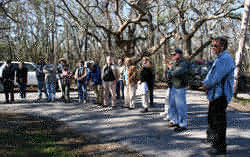Sanctuaries
Orleans Audubon is committed to preserving habitat important to birds in the southeastern United States. We own three sanctuaries which total 195 acres. Our sanctuaries preserve a variety of Louisiana habitats including: bottomland, swamp, marsh, and barrier island forested ridges. We are interested in expanding our existing sanctuaries and in establishing more. We also partner with other organizations to help them create, manage and expand the sanctuaries they own.
 Marguerite Moffett Audubon Sanctuary
Marguerite Moffett Audubon Sanctuary
The Marguerite Moffett Audubon Sanctuary protects 108 acres of brackish marsh and shallow open water on the west side of Hwy. LA 56 near Chauvin, Louisiana, in Terrebonne Parish, along the banks of Bayou Petit Calliou.
Public Amenities: A small parking area on Highway 56 provides access to a 700 foot long boardwalk leading through marsh to overlook-observation platform providing views of Lake Quitman.
Our Partners: The Barataria-Terrebonne National Estuary Program (BTNEP), Terrebonne Parish, Houma Area Convention and Visitors Bureau, Louisiana Recreational Trails Program, Gulf Coast Bird Observatory and the Terrebonne Bird Club. We are especially indebted to Richard DeMay of BTNEP for devoting much time and energy to the boardwalk trail. Click here for more information about the Marguerite Moffett Audubon Sanctuary
 Fischer Wildlife Sanctuary
Fischer Wildlife Sanctuary
Set amid a landscape of braided streams, the Fischer Wildlife Sanctuary preserves 86.5 acres of natural, free-flowing floodplain river system. This regularly inundated bottomland hardwood forest is part of the larger Honey Island Swamp. Located in the Pearl River Basin and St. Tammany Parish, the Sanctuary is bounded to the west by Magnolia Forest Subdivision and to the east by Morgan River, part of Louisiana’s Wild and Scenic River system. The elevation gradient of this site supports a diverse forested wetland dominated by various oaks and sweetgum in the higher areas, and bald cypress and water tupelo stands in the lower, wetter areas. A few magnificent, virgin bald cypress trees can be found and younger cypress trees are numerous. The Sanctuary is also home to a rare and delicate jewel of the swamp—the green fly orchid.Click here for more information about the Fischer Wildlife Sanctuary
Copeland Grand Isle Sanctuary
The Copeland Grand Isle Sanctuary consists of 0.34 acre of maritime live oak forest, referred to in coastal Louisiana by its French-derived name, chenier. Located on the barrier island of Grand Isle in Jefferson Parish, this land was donated by long-time Orleans Audubon Society member Marion Muller Copeland on November 12, 2003. The Sanctuary is part of the Barataria-Terrebonne Important Bird Area an area of worldwide significance to birds. Currently under technical review, this Important Bird Area is important at either a global or continental level to at least 12 species of birds (Driscoll 2009). The importance of even small stands of chenier forest, such as those preserved at the Copeland Sanctuary, is described in the next section. This sanctuary is not yet accessible to the public.
 Partner: Grand Isle Migratory Bird Sanctuary
Partner: Grand Isle Migratory Bird Sanctuary
The Grand Isle Migratory Bird Sanctuary is owned and managed by The Nature Conservancy of Louisiana (TNCL). The Sanctuary was created to protect critically important migratory bird stopover habitat. The barrier island’s location on the northern perimeter of the Gulf of Mexico makes it a point of first and last landfall for birds migrating across the Gulf. The forest on Grand Isle provides prime stopover habitat for Neotropical migratory birds because the live oak trees, associated chenier vegetation and ponds provide not only a place of rest but also food, fresh water, and shelter. Click here for more information about the Fischer Wildlife Sanctuary